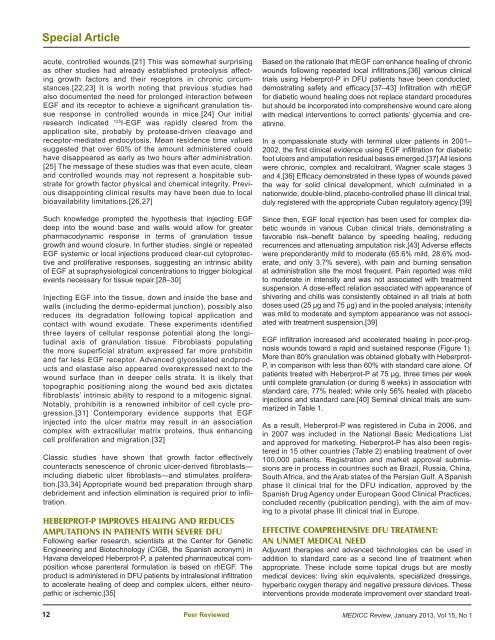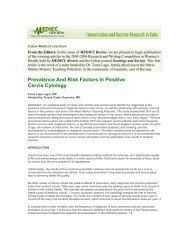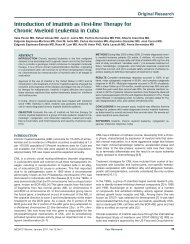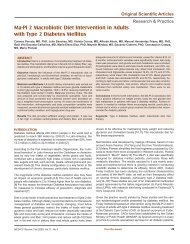Heberprot-P: A Novel Product for Treating Advanced Diabetic Foot ...
Heberprot-P: A Novel Product for Treating Advanced Diabetic Foot ...
Heberprot-P: A Novel Product for Treating Advanced Diabetic Foot ...
Create successful ePaper yourself
Turn your PDF publications into a flip-book with our unique Google optimized e-Paper software.
Special Article<br />
acute, controlled wounds.[21] This was somewhat surprising<br />
as other studies had already established proteolysis affecting<br />
growth factors and their receptors in chronic circumstances.[22,23]<br />
It is worth noting that previous studies had<br />
also documented the need <strong>for</strong> prolonged interaction between<br />
EGF and its receptor to achieve a significant granulation tissue<br />
response in controlled wounds in mice.[24] Our initial<br />
research indicated 125 I-EGF was rapidly cleared from the<br />
application site, probably by protease-driven cleavage and<br />
receptor-mediated endocytosis. Mean residence time values<br />
suggested that over 60% of the amount administered could<br />
have disappeared as early as two hours after administration.<br />
[25] The message of these studies was that even acute, clean<br />
and controlled wounds may not represent a hospitable substrate<br />
<strong>for</strong> growth factor physical and chemical integrity. Previous<br />
disappointing clinical results may have been due to local<br />
bioavailability limitations.[26,27]<br />
Such knowledge prompted the hypothesis that injecting EGF<br />
deep into the wound base and walls would allow <strong>for</strong> greater<br />
pharmacodynamic response in terms of granulation tissue<br />
growth and wound closure. In further studies, single or repeated<br />
EGF systemic or local injections produced clear-cut cytoprotective<br />
and proliferative responses, suggesting an intrinsic ability<br />
of EGF at supraphysiological concentrations to trigger biological<br />
events necessary <strong>for</strong> tissue repair.[28–30]<br />
Injecting EGF into the tissue, down and inside the base and<br />
walls (including the dermo-epidermal junction), possibly also<br />
reduces its degradation following topical application and<br />
contact with wound exudate. These experiments identified<br />
three layers of cellular response potential along the longitudinal<br />
axis of granulation tissue. Fibroblasts populating<br />
the more superficial stratum expressed far more prohibitin<br />
and far less EGF receptor. <strong>Advanced</strong> glycosilated endproducts<br />
and elastase also appeared overexpressed next to the<br />
wound surface than in deeper cells strata. It is likely that<br />
topographic positioning along the wound bed axis dictates<br />
fibroblasts’ intrinsic ability to respond to a mitogenic signal.<br />
Notably, prohibitin is a renowned inhibitor of cell cycle progression.[31]<br />
Contemporary evidence supports that EGF<br />
injected into the ulcer matrix may result in an association<br />
complex with extracellular matrix proteins, thus enhancing<br />
cell proliferation and migration.[32]<br />
Classic studies have shown that growth factor effectively<br />
counteracts senescence of chronic ulcer-derived fi broblasts—<br />
including diabetic ulcer fi broblasts—and stimulates proliferation.[33,34]<br />
Appropriate wound bed preparation through sharp<br />
debridement and infection elimination is required prior to infi ltration.<br />
HEBERPROT-P IMPROVES HEALING AND REDUCES<br />
AMPUTATIONS IN PATIENTS WITH SEVERE DFU<br />
Following earlier research, scientists at the Center <strong>for</strong> Genetic<br />
Engineering and Biotechnology (CIGB, the Spanish acronym) in<br />
Havana developed <strong>Heberprot</strong>-P, a patented pharmaceutical composition<br />
whose parenteral <strong>for</strong>mulation is based on rhEGF. The<br />
product is administered in DFU patients by intralesional infi ltration<br />
to accelerate healing of deep and complex ulcers, either neuropathic<br />
or ischemic.[35]<br />
12<br />
Peer Reviewed<br />
Based on the rationale that rhEGF can enhance healing of chronic<br />
wounds following repeated local infi ltrations,[36] various clinical<br />
trials using <strong>Heberprot</strong>-P in DFU patients have been conducted,<br />
demostrating safety and effi cacy.[37–43] Infi ltration with rhEGF<br />
<strong>for</strong> diabetic wound healing does not replace standard procedures<br />
but should be incorporated into comprehensive wound care along<br />
with medical interventions to correct patients’ glycemia and creatinine.<br />
In a compassionate study with terminal ulcer patients in 2001–<br />
2002, the fi rst clinical evidence using EGF infi ltration <strong>for</strong> diabetic<br />
foot ulcers and amputation residual bases emerged.[37] All lesions<br />
were chronic, complex and recalcitrant, Wagner scale stages 3<br />
and 4.[36] Effi cacy demonstrated in these types of wounds paved<br />
the way <strong>for</strong> solid clinical development, which culminated in a<br />
nationwide, double-blind, placebo-controlled phase III clinical trial,<br />
duly registered with the appropriate Cuban regulatory agency.[39]<br />
Since then, EGF local injection has been used <strong>for</strong> complex diabetic<br />
wounds in various Cuban clinical trials, demonstrating a<br />
favorable risk–benefi t balance by speeding healing, reducing<br />
recurrences and attenuating amputation risk.[43] Adverse effects<br />
were preponderantly mild to moderate (65.6% mild, 28.6% moderate,<br />
and only 3.7% severe), with pain and burning sensation<br />
at administration site the most frequent. Pain reported was mild<br />
to moderate in intensity and was not associated with treatment<br />
suspension. A dose-effect relation associated with appearance of<br />
shivering and chills was consistently obtained in all trials at both<br />
doses used (25 μg and 75 μg) and in the pooled analysis; intensity<br />
was mild to moderate and symptom appearance was not associated<br />
with treatment suspension.[39]<br />
EGF infi ltration increased and accelerated healing in poor-prognosis<br />
wounds toward a rapid and sustained response (Figure 1).<br />
More than 80% granulation was obtained globally with <strong>Heberprot</strong>-<br />
P, in comparison with less than 60% with standard care alone. Of<br />
patients treated with <strong>Heberprot</strong>-P at 75 μg, three times per week<br />
until complete granulation (or during 8 weeks) in association with<br />
standard care, 77% healed; while only 56% healed with placebo<br />
injections and standard care.[40] Seminal clinical trials are summarized<br />
in Table 1.<br />
As a result, <strong>Heberprot</strong>-P was registered in Cuba in 2006, and<br />
in 2007 was included in the National Basic Medications List<br />
and approved <strong>for</strong> marketing. <strong>Heberprot</strong>-P has also been registered<br />
in 15 other countries (Table 2) enabling treatment of over<br />
100,000 patients. Registration and market approval submissions<br />
are in process in countries such as Brazil, Russia, China,<br />
South Africa, and the Arab states of the Persian Gulf. A Spanish<br />
phase II clinical trial <strong>for</strong> the DFU indication, approved by the<br />
Spanish Drug Agency under European Good Clinical Practices,<br />
concluded recently (publication pending), with the aim of moving<br />
to a pivotal phase III clinical trial in Europe.<br />
EFFECTIVE COMPREHENSIVE DFU TREATMENT:<br />
AN UNMET MEDICAL NEED<br />
Adjuvant therapies and advanced technologies can be used in<br />
addition to standard care as a second line of treatment when<br />
appropriate. These include some topical drugs but are mostly<br />
medical devices: living skin equivalents, specialized dressings,<br />
hyperbaric oxygen therapy and negative pressure devices. These<br />
interventions provide moderate improvement over standard treat-<br />
MEDICC Review, January 2013, Vol 15, No 1






